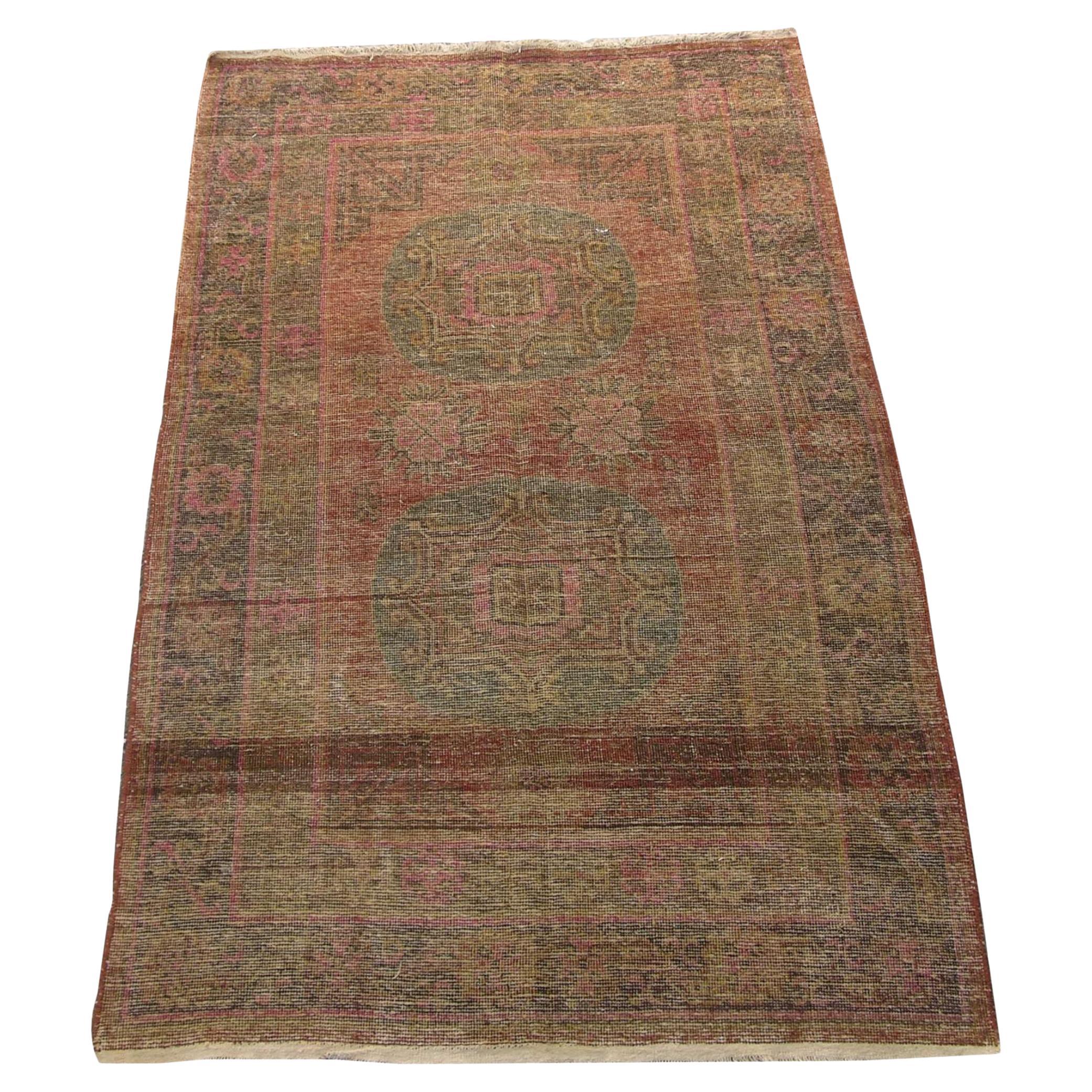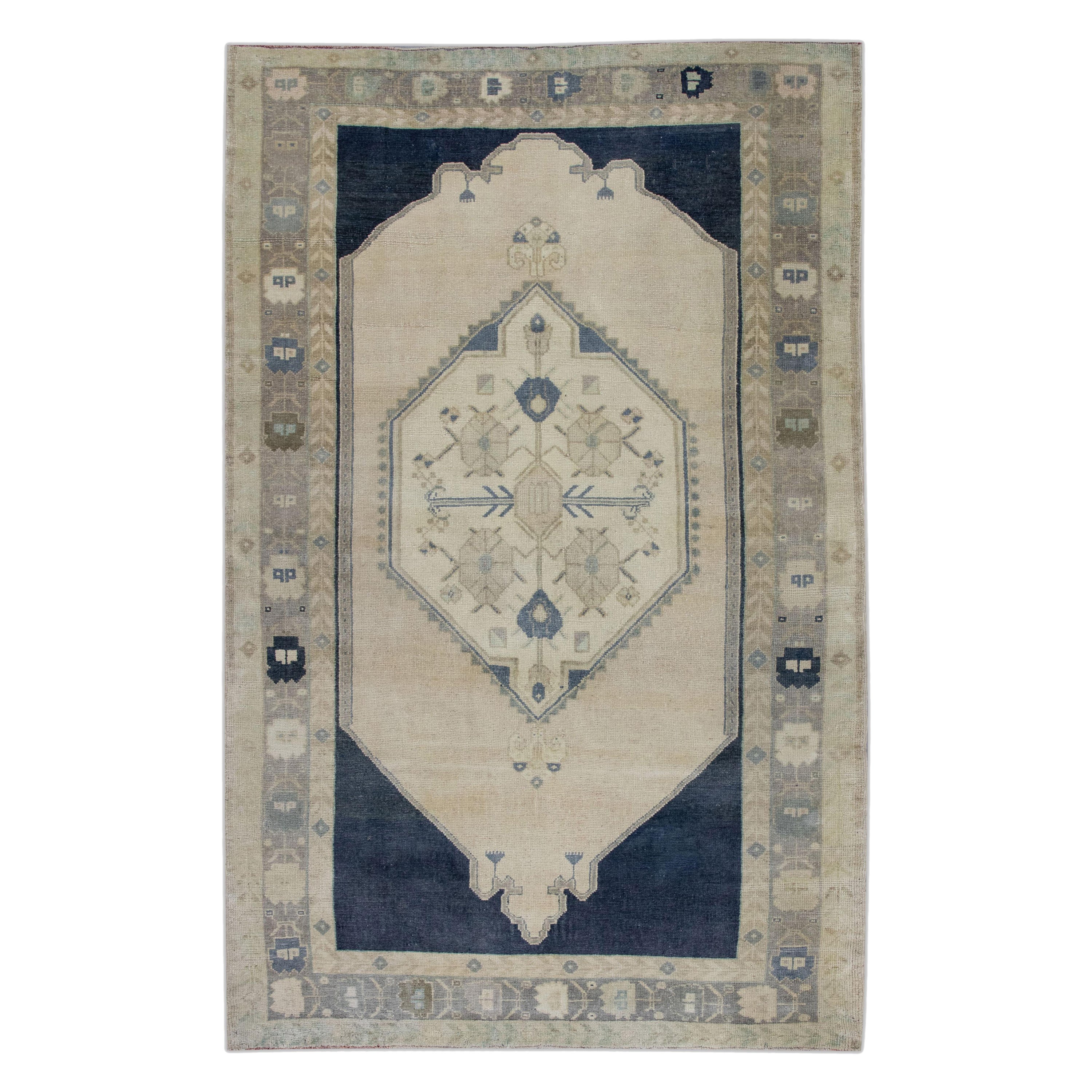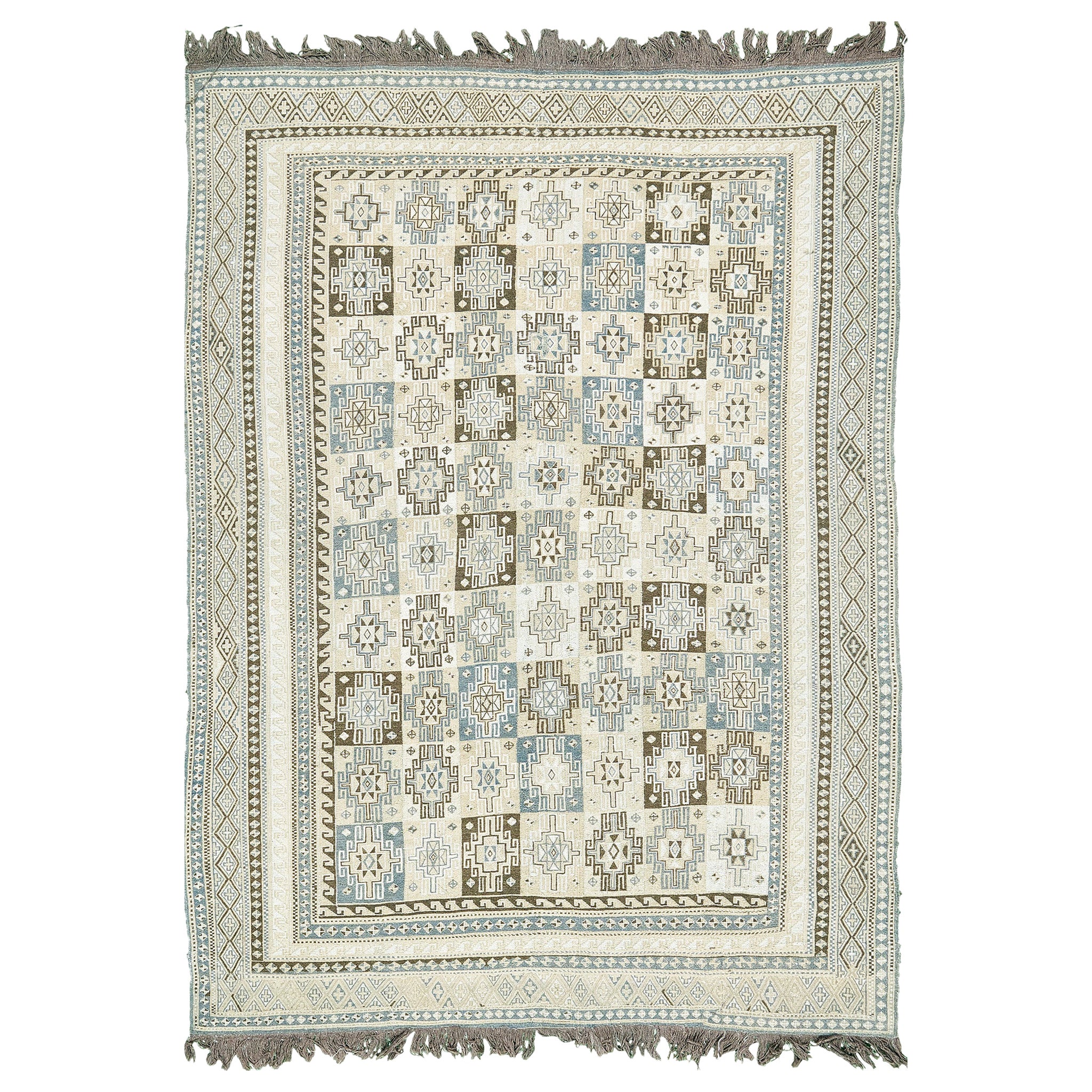Items Similar to Vintage Tribal Silk Soumak - 6'9'' X 4'3''
Want more images or videos?
Request additional images or videos from the seller
1 of 5
Vintage Tribal Silk Soumak - 6'9'' X 4'3''
About the Item
Soumak rugs (also spelled Sumak) – This construction technique produces a flat-weave rug that is thick, strong and exceptionally durable. Unlike kilims, Soumak rugs are not reversible because non-clipped yarns are left on the back. However, they are also stronger than kilims.
Antique Soumak carpets are unique because the wefts are used to produce decorative patterns rather than as a structural element. Antique Soumak rugs are generally very finely woven and feature richly detailed motifs. Traditionally, these spectacular flat-weave carpets are decorated with ancient symbols, tiny birds and geometric animals. Many of these geometric patterns and tribal symbols are associated with the Shahsavan tribe. In the 17th century, these influential warriors served as the personal bodyguards to Shah Abbas according to historic legends. The Shahsavan, who used Soumak weaving techniques widely, inhabited modern-day Azerbaijan and parts of Northwest Persia near Ardabil.
Because Soumak rugs were woven in various carpet producing regions, the designs they feature are exceptionally diverse. Although they are fairly rare compared to pile carpets and traditional kilims, antique Soumak rugs feature grand medallions, finely executed repeating patterns, Persian garden designs and tribal motifs that are surrounded by multiple sets of richly detailed borders. Antique Soumak rugs make outstanding floor coverings, but the technique was also used to construct bags, trappings, saddle covers, decorative bed spreads and functional household items. Like other regional handicrafts, antique Soumak rugs are highly decorative and diverse textile pieces that flatter modern furnishings and soften minimalist interiors very well.
Soumak or Sumak is a type of brocading or flat-woven pile. Thicker than a kilim carpet, it is accomplished by looping the yarn horizontally around successive pairs of warps in between passes of over-under wefting. When compressed vertically with a weaver’s comb, the resultant texture looks like cabling rising slightly from the surface of the rug. Soumak is named for the village of Shemaka in the Caucasus where this technique was widely practiced, but it certainly was not invented there. Soumak has been practiced extensively across the antique rug producing world, from Central Asia to Iran, the Caucasus, and Turkey.
Antique Soumak Weave Techniques:
Soumak Weave – The art of fine rug weaving and making is ancient and complex. Over the centuries, a myriad of disparate cultures, from every corner of the globe, have developed methods of creating tight, long-lasting weaves, such as rugs, carpets, and kilims.
As such, there is no singular, universal method for creating a fine weave; rather, there are several different, totally distinctive weaving techniques. These techniques and approaches have been developed over time and that are unique to the area, tribe and or people.
One specific example of a type of weave that was developed and is still used to this day is the Soumak weave. The widespread adaptation of the Soumak weave by such a wide range of different rug-producing cultures is certainly a rather strong testament to the quality and “reproducibility” of the process — cornerstones of any long-lasted artistic technique.
One of the most familiar types of antique weaving from the Caucasus region is the Soumak. These were produced in a wide array of designs, but generally they are typified by a crisp, precise drawing applied to highly abstract or stylized geometric patterns, using a rich and varied palette.
In technical terms, Soumaks are flatwoven rugs. Their technique is related to that of kilims, but it is somewhat more complex, thicker in handle, and more durable as floor covering. As opposed to Kilim technique which consists of compacted weft facing simply running over and under the vertical wraps, Soumak weave runs the yarns around the warps in a serpentine pattern, over two, back one, over two back one, and so forth.
The rows of this yarn facing or brocading are then separated by wefts like the rows of knots in pile carpets. The origin of this technique is hard to pinpoint, but it is attested literally from one end of the rug-producing world to the other.
The term Soumak is apparently a corruption of the name Shemaka, a town in the Shirvan region of the Caucasus, where such rugs, it is often claimed, were made. However Soumaks were made in various areas of the Caucasus and the region north of Kuba seems to have been a major center of their production.
Caucasian Soumaks have a very interesting design repertory, with a number of distinct types or groups. From the perspective of carpet history, the most interesting group is the one that utilizes field designs of large polygonal medallions, often in the shape of diamonds or stars.
These tend to be modeled on early Turkish pile carpets, especially those of the so-called “small pattern Holbein” and “large pattern Holbein” types produced in Western Turkey during the fifteenth and sixteenth centuries. A key feature of the Holbein rugs is the use of small squares with horn-like hooked pairs as fillers in the indentations along the edge of the main medallions.
Caucasian Soumaks of this type reproduce even these details with remarkable consistency and fidelity. The various smaller motifs used as space fillers seem to come from the common tribal repertory behind most Caucasian and Turkish rugs. The borders of Caucasian Soumaks tend to be made up of small geometric medallions or stylized rosettes, although they can be surprising, as on the example shown here which is adapted from kilim designs.
A second major group of Caucasian Soumaks have allover field designs made up of smaller medallions arranged closely in staggered repetition. Some of these which have multi-pointed star-like configuration (the so-called Crivelli-Star) also come from the repertory of early Turkish rugs. But the oval medallions with undulating edges are floral palmettes of classical Persian derivation.
Despite the varied origins of the design elements, the Soumaks of this group still convey considerable stylistic homogeneity or integrity. The borders of this second group are much the same as those of the first, although the example shown here has a highly unusual border that derives once again from early Turkish rugs.
A third group of Caucasian Soumaks stems from more local traditions. Known as “Dragon Soumaks,” these are clearly derived from the classical Caucasian Dragon rugs produced from the end of the sixteenth to the early eighteenth centuries.
The Dragon Rugs themselves were Caucasian workshop productions based on imported Kerman Persian Vase carpets, although the precise area of their manufacture is still unclear. The Soumaks of this kind were probably patterned on the village derivatives of the Dragon rugs that were produced in the Karabagh region during the later eighteenth and early nineteenth centuries.
Another, possibly related type are the Verneh Soumaks that have designs consisting of large, angular S-shaped motifs which are generally thought to be dragons, although in most cases they are no longer recognizable as such.
While the design sources of the nineteenth century Caucasian Soumak production are not particularly mysterious, it is still unclear what exactly prompted their manufacture. The overwhelming majority of these pieces belongs to the later nineteenth century. They are part and parcel of the veritable explosion of rug production and export that took place in the Caucasus at this time under official Russian supervision.
But although one can trace the development of Caucasian pile rugs almost continuously from the later seventeenth and eighteenth centuries right into the nineteenth and twentieth, it is difficult to identify Caucasian Soumaks older than 1850 with any certainty, although the technique must have been known in the Caucasus long before this time. The later nineteenth-century Caucasian Soumak production essentially emerged out of nowhere.
Equally obscure are the reasons behind the specific selection of design models of classical Turkish and Persian origin. Perhaps this choice suggests that the weavers or those who supervised the production of Soumaks sought to tap into a market for what were then antique-looking pieces.
Early Turkish and Persian rugs were already highly collectible and sought after in the nineteenth century. We may certainly imagine that the weavers or designers of these Soumaks had access to the sort of early Turkish carpets which served as the prototypes.
Such heirlooms could well have been in the possession of the local Caucasian peoples who made these Soumaks, especially Armenians, who had long been involved the trade of Turkish carpets across the Middle East and the Mediterranean.
Consequently, nineteenth-century Caucasian Soumaks appear to have been a conscious antiquarian production, a retrospective homage to the great early traditions of Turkish, Caucasian, and Persian weaving. As such they may appeal to us all the more today, now that the interest in classical Turkish and Persian rugs has grown exponentially.
- Dimensions:Width: 51 in (129.54 cm)Length: 81 in (205.74 cm)
- Style:Tribal (In the Style Of)
- Materials and Techniques:
- Period:
- Date of Manufacture:1970
- Condition:Excellent Condition.
- Seller Location:Los Angeles, US
- Reference Number:
About the Seller
5.0
Gold Seller
These expertly vetted sellers are highly rated and consistently exceed customer expectations.
Established in 1920
1stDibs seller since 2023
26 sales on 1stDibs
Typical response time: <1 hour
- ShippingRetrieving quote...Ships From: Los Angeles, US
- Return PolicyA return for this item may be initiated within 3 days of delivery.
More From This SellerView All
- Antique Uzbek Samarkand Tribal Rug 7'7'' X 4'3''Located in Los Angeles, USAntique Uzbek Samarkand Tribal Rug 7'7'' X 4'3''Category
Antique Early 1900s Uzbek Tribal Russian and Scandinavian Rugs
MaterialsWool, Cotton
- 1920s Vintage Flat Weave Decorative Soumak RugLocated in Los Angeles, USoumak rugs (also spelled Sumak) – This construction technique produces a flat-weave rug that is thick, strong and exceptionally durable. Unlike kilims, Soumak rugs are not reversible...Category
Vintage 1920s Tribal Russian and Scandinavian Rugs
MaterialsWool
- Antique Nomadic Sumak Rug - 5'10'' X 4'3''Located in Los Angeles, USAntique Nomadic Rugs: – To most people the concept of the area rug, especially the pile rug, is virtually synonymous with the Orient, above all P...Category
Vintage 1910s Tribal Russian and Scandinavian Rugs
MaterialsWool
- 1920 Antique English Fragment Rug 3'6'' X 4'3''Located in Los Angeles, USCa.1920 Antique English Fragment Rug 4'3'' X 3'6'', handmade and hand-knotted piece , came from Europe to america back in 1950s and was made by weavers in Europe around 1920s. Englis...Category
Vintage 1920s Asian Other Russian and Scandinavian Rugs
MaterialsWool, Cotton
- Early 20th Century Antique Kilim Floral Design Rug - 12'7'' X 6'9''Located in Los Angeles, USAntique Bessarabian Rugs / Kilims in both pile and tapestry weaving technique are some of the more beautiful carpets to have been produced in Europe. Many of the Bessarabian Kilims w...Category
Antique Early 1900s Asian Other Russian and Scandinavian Rugs
MaterialsWool, Cotton
- 1900s Authentic Tribal Floral Khotan RugLocated in Los Angeles, USAntique Samarkand Rugs: The desert oasis of Khotan was an important stop on the Silk Road. The people of Khotan were expert carpet weavers who produced high quality antique rugs and ...Category
Antique 19th Century Tribal Russian and Scandinavian Rugs
MaterialsWool, Cotton
You May Also Like
- Antique Caucasian Soumak Rug with Tribal StyleLocated in Dallas, TX74375, antique Caucasian Soumak rug with tribal style. Embodying tribal style and nomadic charm with saturated colors, this handwoven wool antique Caucasian Soumak rug is a captivati...Category
Early 20th Century Russian Tribal Caucasian Rugs
MaterialsWool
- Antique Caucasian Tribal Soumak RugLocated in WEST HOLLYWOOD, CARug Number 55398 Size 5' 6" X 10' 6" Design Soumak Collection Antique/Vintage Material Wool Texture Flat Weave Origin Russia Age Antique/Vintage.Category
Antique Early 1900s Russian Russian and Scandinavian Rugs
MaterialsWool
- Handmade Vintage Turkish Rug 4'3"x 6'9"By Asian ModernLocated in Houston, TXIntroducing a one-of-a-kind vintage Turkish hand-knotted wool rug, carefully crafted by skilled artisans using traditional techniques passed down through generations. This exquisite ...Category
Vintage 1960s Turkish Tribal Turkish Rugs
MaterialsWool
- Vintage Northwest Soumak RugLocated in WEST HOLLYWOOD, CARug Number 3429 Size 6' 6" X 9' 2" Design Soumak Collection Antique/Vintage, Flat Weaves Material Wool Texture Flat Weave Origin Russia Age Antique/VintageCategory
Vintage 1940s Russian Russian and Scandinavian Rugs
MaterialsWool
- Antique Caucasian SoumakLocated in WEST HOLLYWOOD, CARug Number 27105 Size 8' 11" X 10' 0" Design Soumak Collection Antique/Vintage Material Wool Texture Flat Weave Origin Russia Age Antique/VintageCategory
Antique Early 1900s Russian Russian and Scandinavian Rugs
MaterialsWool
- Antique Soumak Kilim Rug in Red, Black Border with Tribal Pattern by Rug & KilimLocated in Long Island City, NYFrom our celebrated flatweave collection, a 5x7 antique Soumak kilim rug originating from Russia circa 1910-1920. The collectible opts for minimalism ...Category
Vintage 1910s Russian Kilim Russian and Scandinavian Rugs
MaterialsWool





